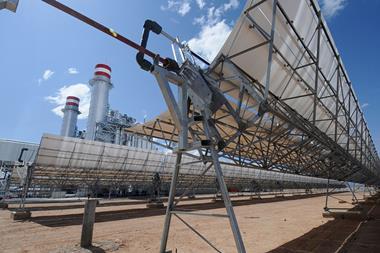What are some of the key considerations involved in “aligning portfolios with the Paris Agreement”? Adam Matthews, director of ethics and engagement at Church of England Pensions Board, and Lucian Peppelenbos, senior responsible investment and governance specialist at APG Asset Management, provide an update on a project from the Institutional Investors Group on Climate Change (IIGCC).
Climate change now tops the rankings of risks faced by investors. From the World Economic Forum to analysis from Willis Towers Watson’s Thinking Ahead Institute published earlier this month, it is consistently cited among the most significant threats facing the global economy today and in the future.
At the same time, in the words of Al Gore, it is seen as “the largest investment opportunity of our generation”. In Europe alone €180bn is required in additional yearly investments to 2030 to meet the Paris Agreement’s targets.
The Paris Agreement is the policy framework the world is working to in order to address the issue. Ensuring we deliver on its goal of limiting warming to well below 2°C – or a preferred 1.5°C – above pre-industrial levels is vital if we are to avoid devastating environmental, social, economic and financial impacts. The transition this entails will lead to a fundamental restructuring of the world’s economy, potentially requiring equally significant changes in how we manage our investment portfolios.
Understanding how we might align our investment portfolios with the goals of the Paris Agreement is crucial in helping us to capture opportunities and drive necessary decarbonisation, while helping minimise the negative consequences of to the impacts of climate change and the transition under way. Some investors have begun to consider this individually, but we lack a common understanding of the best methods and approaches across different asset classes and sectors.

That is why, in May, the IIGCC launched the Paris-Aligned Investment Initiative to help investors understand what this means in practice. It involves identifying methodologies and approaches to enable investors to transition their portfolios and measure alignment against the goals of the Paris Agreement.
To paraphrase the agreement itself, this means “making finance flows consistent with a pathway towards low greenhouse gas emissions and climate-resilient development”.
IIGCC has brought together leading investors to drive the initiative forward. As joint chairs, we have the privilege of working with senior colleagues from Sweden’s AP2, the UK’s Brunel Pension Partnership, LGPS Central, and TPT Retirement Solutions, and Denmark’s PKA, as other members of the initiative’s steering committee. A host of other investors are involved in the working groups we are establishing to take dedicated asset class work streams forward.
While there will be no ‘one size fits all’ approach to ‘Paris-aligned’ investment, our work to date points to fundamental considerations that will shape those approaches that do emerge.
What are portfolios to be aligned to?
The Paris Agreement was devised by governments for governments, not for institutional investors. This means we need to identify and ‘translate’ aspects of the agreement that do relate to the investment process and define how they apply.

Of most significance is the emerging consensus that limiting warming to 1.5°C above pre-industrial levels means ensuring we achieve carbon neutrality – or ‘net zero’ emissions – across the global economy by 2050.
What that means for different industry sectors, regions and asset classes is, however, undefined in the Paris Agreement. That is one of the questions that we as investors need to answer.
What does alignment mean in practice?
Aligning a portfolio to a temperature goal has two dimensions. Reducing the carbon footprint of investments consistent with net zero emissions across economies is one necessary aspect. But to decarbonise the global economy also requires increased investment in ‘climate solutions’.
Whether it is renewable energy, the circular economy, or sustainable infrastructure development, there are innumerable proven and emerging investment options – by project, sector or asset class – that support the transition to a net zero economy, while also providing healthy and stable returns in the process. A portfolio that fails to address both aspects will not be utilising its capital effectively in support of the Paris Agreement.
Will this impact financial performance?
Given their fiduciary duty, investors will rightly need to assess the impact of portfolio shifts on returns. The policy, technology and market changes associated with the transition to a decarbonised global economy are already under way. These pose material risks to investors if decision-making is out of sync with a changing investment outlook.
Working to Paris alignment across portfolios can help reduce associated risks and exposure, while offering opportunity to grow returns through investment in the expanding market for low-carbon technologies and assets.
This in simple terms is about ensuring investors stay ahead of the curve, to avoid the consequences of being caught on the wrong side of climate-related ‘transition risk’.
What approach should investors take in achieving alignment?
“We need a better understanding of which approaches are most appropriate in which circumstances, and the pros and cons of using them together”
This is possibly the most challenging question and one to which there is unlikely to be a simple answer. Each approach has its limitations. For example, the UK’s Universities Superannuation Scheme recently convened asset owners to help understand the limitations of carbon footprinting when applied across multiple asset classes.
There are other emerging alternatives, including criteria-based inclusion/exclusion approaches aided by the EU sustainable finance taxonomy . New approaches are being developed for different asset classes such as the recently announced CRREM initiative on decarbonisation pathways for real estate.
Given the varying characteristics of different asset classes and existing range of approaches, we need to establish a better understanding of which approaches are most appropriate in which circumstances, and the pros and cons of using them together to achieve robust outcomes.
Will alignment achieve the intended climate impacts?

If investors are to make a meaningful contribution to the Paris Agreement’s goals it is important to think not just about decarbonising a portfolio – which might simply involve selling some high-carbon assets – but how investor action can have the greatest influence on reducing emissions in the real economy.
As part of the IIGCC’s work, we are looking at the extent to which these different approaches can help achieve the intended climate impacts. This is important in ensuring investors can be clear on what approaches are most relevant for them and the implications of alternative options.
Answering these questions will help provide clarity on the methodologies and pathways investors can use to put theory into practice. It is only by beginning to transition portfolios on scale, in a way that works across asset classes, that we can achieve the systemic shift in investment flows required across the global economy to deliver on the goals of the Paris Agreement.
Global leaders gathered in New York this week for a specially convened UN Climate Action Summit. Hosted by UN secretary-general António Guterres, it sought to bring forward more of the ambition we require from key actors to deliver the Paris Agreement.
With work of IIGCC’s initiative well under way, our growing group of investors are demonstrating not just ambition but action. We hope many other investors will join us in this process.
The authors were writing in their capacity as joint co-chairs of the IIGCC’s Paris Aligned Investment Initiative
Note: This article was updated on 27 September to correct the spelling of CRREM and the website link

















No comments yet